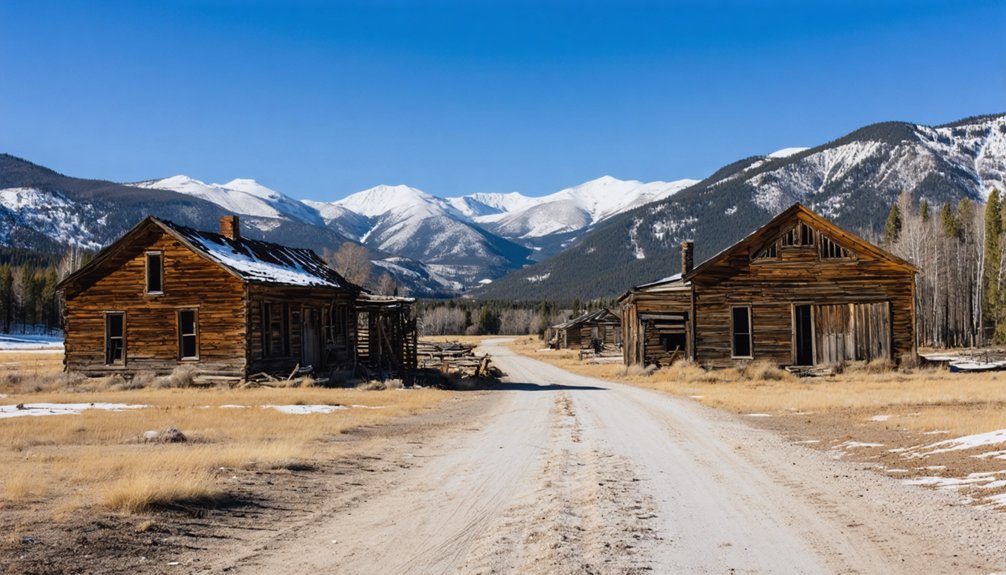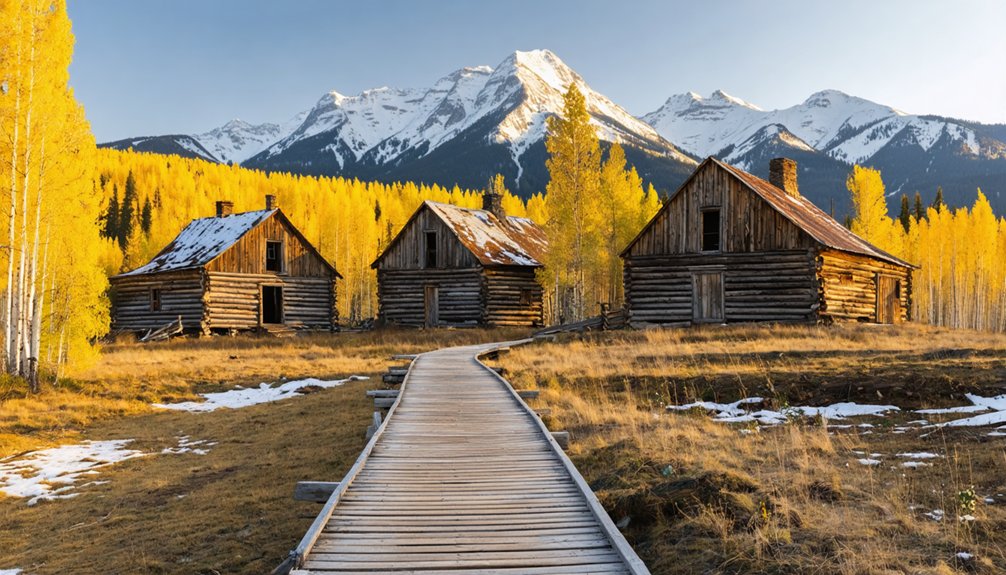You’ll discover Ashcroft Ghost Town 11 miles from Aspen, Colorado, where silver’s discovery in 1880 sparked a bustling mining settlement of 16,000 residents. The town flourished with six hotels and 20 saloons until depleted silver deposits and Aspen’s rail connection led to its decline by 1884. Today, you can explore three fully restored buildings, including the Blue Mirror Saloon, and six weathered structures that tell the tale of Colorado’s mining heritage.
Key Takeaways
- Ashcroft was a booming silver mining town established in 1880 that peaked with 16,000 residents before declining into a ghost town by 1912.
- Located 11 miles from Aspen at 9,521 feet elevation, the ghost town features three restored buildings and six unrestored historic structures.
- The town’s rapid decline began in 1884 when shallow silver deposits were depleted, causing miners to relocate to more prosperous areas.
- Visitors can explore preserved buildings including the Blue Mirror Saloon through guided tours offered by the Aspen Historical Society.
- During its peak, Ashcroft supported a vibrant community with six hotels, 20 saloons, and paved roads centered around silver mining.
The Birth of a Silver Mining Town
Two prospectors from Leadville, Charles B. Culver and W.F. Coxhead, struck silver in Castle Creek Valley during the spring of 1880. Much like the gold rush era that preceded it, word of their discovery spread quickly, drawing 23 enthusiastic prospectors to the site.
They established Castle Forks City, though you’d soon know it as Ashcroft.
Within just two weeks, the Miners Protective Association transformed the rugged landscape into an organized settlement. At 9,521 feet elevation, the town rapidly evolved into a mining technology hub near the Crested Butte railway. At its peak, the bustling town supported a population of 16,000 residents. This prosperity was short-lived as the town became a ghost town by 1912.
From Boom to Bust: A Tale of Two Cities
Although Ashcroft’s early prosperity seemed boundless, the town’s fortunes began to crumble by 1884. The exceptionally rich silver deposits, yielding an impressive 14,000 ounces per ton, proved shallow and quickly depleted. As mining decline set in, a devastating economic downturn followed.
You’ll find the story of Ashcroft intertwined with Aspen’s rise. When richer silver strikes were discovered in Aspen, miners and investors abandoned Ashcroft in droves. The town’s inclusion on multiple disambiguation pages helps researchers distinguish it from other places named Ashcroft.
The final blow came when the Denver & Rio Grande Railroad chose Aspen for its rail line in 1887, leaving Ashcroft isolated and uncompetitive. Without proper transportation infrastructure, the town couldn’t survive. The post office closed in 1912, marking the town’s complete transformation into a ghost town.
Life in 1880s Ashcroft
During its peak years, Ashcroft embodied the energy and spirit of America’s mining frontier. You’d find yourself among 2,000-3,500 residents, experiencing a bustling town with six hotels and 20 saloons. The town’s economic activities centered around silver mining, with sawmills and a smelter processing the precious ore.
You could attend grand social gatherings, including balls and banquets, where you might rub shoulders with notable figures like H.A.W. Tabor.
The well-organized community boasted paved roads, a courthouse built in just two weeks, and two competing newspapers. You’d find lodging at establishments like the Nellie Bird house, and could join local organizations such as the Miner’s Protective Association. The Blue Mirror Saloon remained one of the most popular gathering spots for the town’s miners. Located west of Aspen, the town represented the pioneering spirit of Colorado’s mining era.
The town’s infrastructure reflected its rapid development, showcasing America’s frontier ingenuity at its finest.
Preserved Buildings and Historical Landmarks
You’ll find three fully restored buildings at Ashcroft Ghost Town, including the Blue Mirror Saloon with its period artifacts and interpretive displays.
The Aspen Historical Society maintains and oversees the preservation of this important historical site.
Six additional structures remain in their original, unrestored state, showcasing natural weathering and historic decay.
The site’s preservation efforts focus on stabilizing existing buildings rather than full reconstruction, with some structures braced to prevent collapse while others remain open for visitor exploration.
Tour groups are welcomed at the site, with knowledgeable docents providing guided visits during the tourist season.
Standing Historic Structures
The historic structures of Ashcroft stand as remarkable examples of 19th-century mining town architecture, with several buildings carefully preserved for modern visitors.
You’ll find three fully restored buildings that showcase the architectural significance of the era, including the iconic Blue Mirror Saloon with its mining artifacts and the partially restored Hotel View entrance. Once home to 2,000 residents, the town thrived with numerous amenities during its peak mining years. Visitors can explore these structures while enjoying stunning mountain views along Castle Creek Road. The Post Office and several residential cabins maintain their original character while ensuring visitor accessibility.
Throughout the site, you’ll notice six unrestored buildings that retain their authentic condition, supported by strategic structural bracing.
The town’s layout is cleverly marked by shrubs indicating former building foundations, while interpretive signs guide you through each structure’s history. Original log walls and construction techniques demonstrate the craftsmanship of these 19th-century buildings.
Reconstruction and Preservation Efforts
Since gaining its National Register of Historic Places designation, Ashcroft’s preservation has flourished through partnerships between the Aspen Historical Society and U.S. Forest Service.
You’ll find three fully restored buildings and six maintained in their original condition, showcasing successful restoration techniques despite preservation challenges in the harsh mountain environment.
When you visit, you’ll notice interpretive signage in both English and Spanish guiding you through the site’s history.
A caretaker lives on-site in an authentic cabin during accessible months, helping protect the structures from vandalism while maintaining the grounds.
The $5 entrance fee you pay goes directly toward preservation efforts, including the construction of a new model recreating Castle Avenue from Ashcroft’s mining heyday.
Docents offer guided tours during peak seasons, sharing detailed stories of the town’s past.
Getting There: Location and Best Times to Visit

Located 11 miles up Castle Creek Road from Aspen’s western entrance, Ashcroft Ghost Town sits at an elevation of 9,521 feet within the White River National Forest.
You’ll need a private vehicle to access the site, as there’s no public transportation available. The paved Castle Creek Road becomes narrower and steeper as you ascend, so plan your travel accordingly.
- Summer season (June 14-September 28) offers guided tours and full facility access from 10 am-5 pm
- Spring and fall provide quieter, self-guided experiences with variable weather
- Winter access depends on road conditions – 4WD or snow tires may be required
- Early morning or late afternoon visits offer ideal photography and fewer crowds
Remember to download maps beforehand, as cell service is limited.
There’s a $5 admission fee for adults, while children under 18 and active military enter free.
Native Heritage and Military History
When you explore Ashcroft’s landscape today, you’re walking on ancestral Ute territory where the Tabuache band once established summer hunting camps in the Castle Creek Valley.
The Ute people maintained a sacred connection to the area’s water sources until 1873, when Chief Ouray signed a treaty ceding the land to the U.S. government, leading to their forced removal by 1881.
The valley’s military significance emerged decades later during World War II, when the area served as a training ground for American troops.
Ute Ancestral Hunting Territory
Before becoming a ghost town, Ashcroft sat within the vast ancestral territory of the Ute people, who occupied approximately 150,000 square miles across present-day Colorado, Utah, and parts of New Mexico.
As part of their traditional hunting practices, the Utes moved strategically through the region’s diverse landscapes, following game animals and seasonal plant cycles.
- Seven major Ute bands divided and defended specific hunting territories
- The land provided deer, elk, and small game like rabbits for sustenance
- Hunters utilized natural mineral springs during their seasonal migrations
- The region was part of the “Shining Mountains,” reflecting deep ties to the landscape
World War II Training
During World War II, Ashcroft’s remote mountain terrain transformed from a quiet ghost town into an essential military training ground after Ted Ryan leased the site to the U.S. Army.
You’ll find the footsteps of the elite 10th Mountain Division here, where soldiers endured rigorous mountain warfare training at elevations above 9,500 feet.
These troops tackled technical climbing, rappelling, and bridge construction while battling harsh conditions that mirrored the Italian Apennines.
They’d spend long nights in freezing temperatures, perfecting small-unit tactics and reconnaissance maneuvers.
The training exercises were so demanding that soldiers faced constant challenges from altitude sickness, frostbite, and treacherous terrain.
While few physical remnants remain today, Ashcroft’s military legacy lives on through the National Register of Historic Places and the veterans who later shaped Colorado’s renowned ski industry.
Natural Beauty and Environmental Conservation

Nestled within the White River National Forest at an elevation of 9,500 feet, Ashcroft Ghost Town showcases the pristine beauty of Colorado’s subalpine ecosystem.
You’ll discover vibrant wildflower observation opportunities during summer months, while seasonal changes transform the landscape from muddy spring meadows to golden aspen groves in fall.
As you explore, you’re sharing space with diverse wildlife including elk, marmots, and black bears in their natural habitat.
- Stay on marked trails to protect delicate alpine vegetation
- Pack out all trash to maintain the site’s natural integrity
- Use designated facilities to prevent environmental contamination
- Keep dogs at home to protect native wildlife
Conservation efforts preserve this remote sanctuary through minimal-impact policies, ensuring future generations can experience its untouched splendor while honoring the land’s Native Ute heritage.
The Legacy of Colorado’s Last Residents
While Ashcroft’s population peaked at 2,500 residents in 1883, the town’s swift decline began when its rich silver deposits proved shallow and quickly depleted. By 1912, fewer than 50 residents remained, and the post office closed its doors.
The remaining inhabitants, mostly aging single men, demonstrated remarkable community resilience by maintaining local governance and social bonds despite their dwindling numbers.
Among these final residents was Jack Leahy, nicknamed “Judge,” whose poetry and scholarship contributed to Ashcroft’s cultural legacy until his death in 1939.
You’ll find that these last inhabitants, though faced with economic hardship, preserved their town’s spirit through storytelling at local establishments and regular municipal elections.
Their perseverance in maintaining social institutions offers a compelling glimpse into frontier life’s determination and adaptability.
Frequently Asked Questions
Are There Any Reported Ghost Sightings or Paranormal Activities in Ashcroft?
You won’t find any verified ghost stories or documented paranormal investigations at this location. While visitors occasionally mention a spooky atmosphere, there’s no official evidence of supernatural activity here.
Can Visitors Take Artifacts or Rocks From the Ghost Town Site?
No, you can’t remove anything from the site. Artifact preservation laws strictly prohibit rock collection and taking items. You’ll face legal penalties and fines if you’re caught removing materials.
Is Camping Allowed Within the Ashcroft Ghost Town Boundaries?
Like trying to pitch a tent in a museum, you can’t camp within the ghost town’s boundaries. Camping regulations strictly prohibit overnight stays, but you’ll find available campsites along Pearl Pass Road beyond.
What Wildlife Can Visitors Commonly Encounter While Exploring Ashcroft?
Along nature trails, you’ll spot elk herds, mule deer, and black bears. Mountain bluebirds and golden eagles offer wildlife photography chances, while coyotes’ howls often echo through the area.
Are There Guided Night Tours or Special Events at Ashcroft?
When the sun goes down, you’re out of luck! You won’t find guided night tours here. While daytime guided tours run June through October, special events are mainly held in nearby Aspen instead.
References
- https://sheenashahangian.com/ashcroft-ghost-town-colorado/
- https://www.uncovercolorado.com/ghost-towns/ashcroft/
- https://aspenhistory.org/ashcroft-ghost-town/
- https://www.aspentimes.com/news/two-amateur-historians-bring-ghost-town-of-ashcroft-to-life-with-stories-of-its-people/
- https://www.colorado.com/aspen/ashcroft-ghost-town
- https://en.wikipedia.org/wiki/Ashcroft
- https://aspenchamber.org/blog/ghost-towns-and-cemeteries-visit-aspen-october
- https://welovetoexplore.com/abandoned-mining-town-ashcroft-colorado/
- https://www.allaspen.com/history_museums/ashcroft_ghost_town.php
- https://ladailypost.com/post-from-the-road-ashcroft-colorado/



